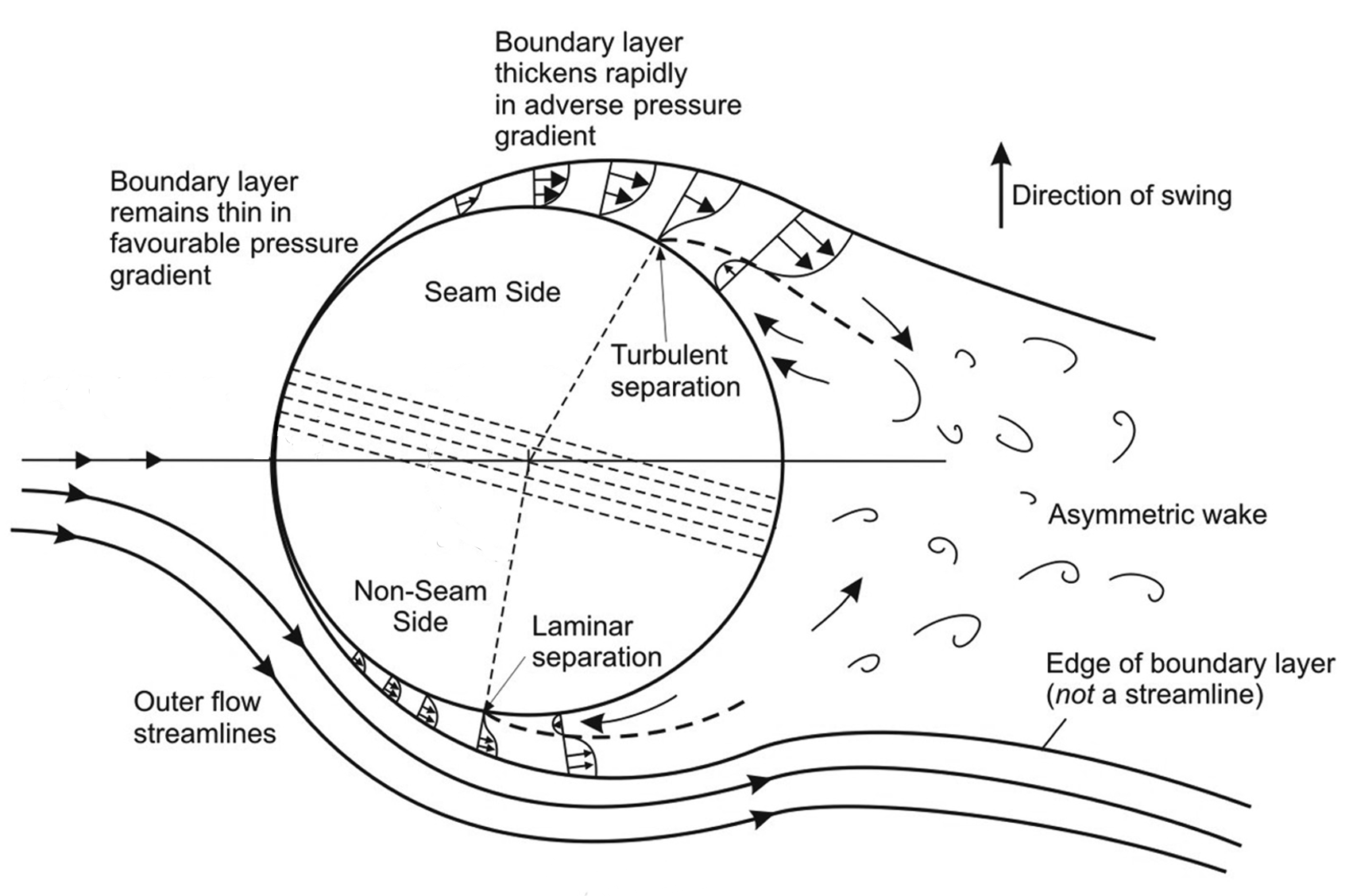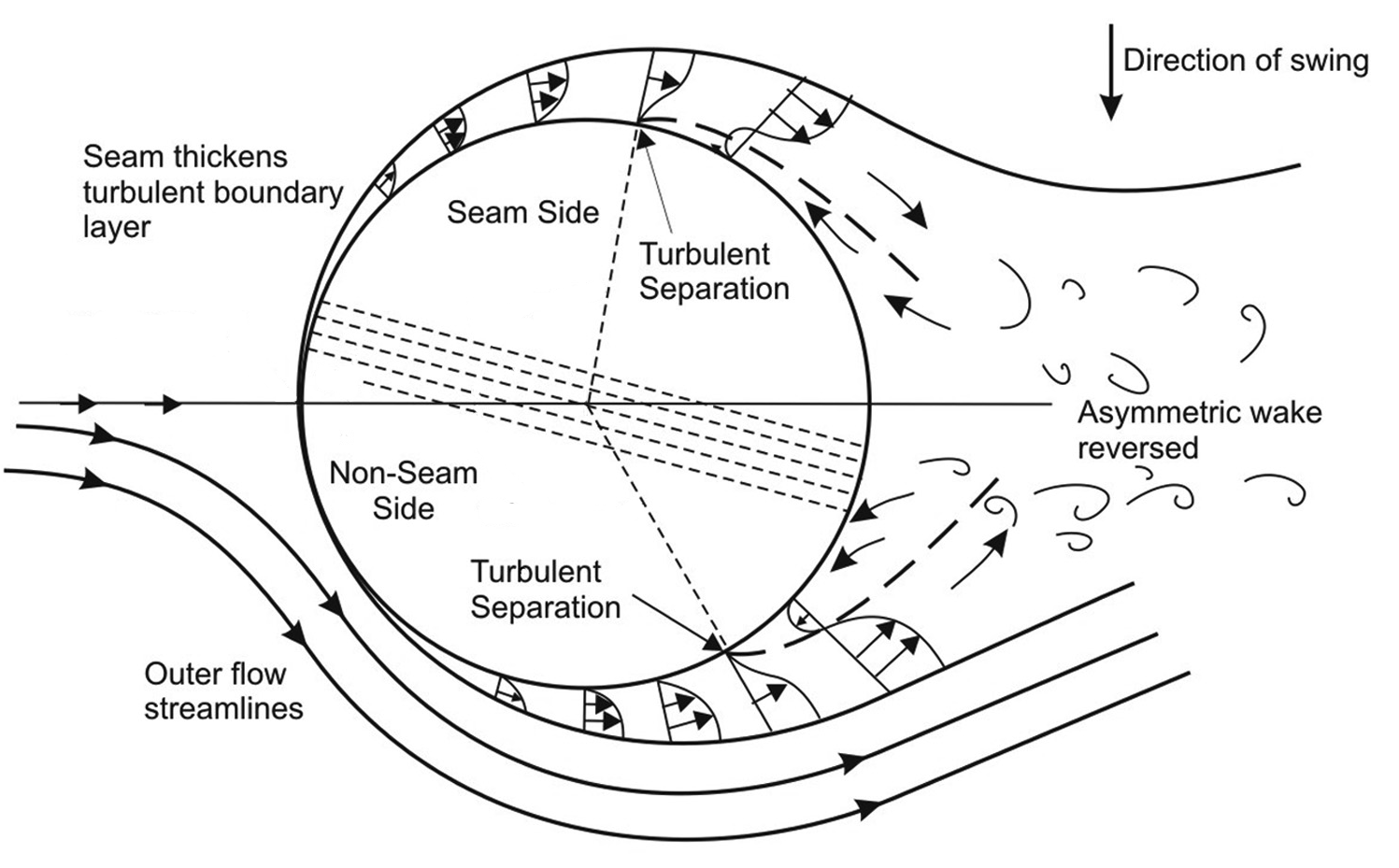Does Weather Affect Swing Bowling?
Much discussion prior to the start of a cricket game is focused on the weather conditions. Commentators often discuss the cloud cover and the part it will play on the game. After the coin toss, the captains often say that they chose to bowl due to cloud cover and try to avoid batting when it is cloudy.
A myth amongst almost the entire cricket community, including professionals, is that the increased cloud cover and subsequent increased humidity will cause the ball to swing more. The rationale is that the increased moisture in the air affects the flow of air around the ball by making it slower and so the ball would swing more 1.
This has traditionally been backed up by looking at how successful bowlers have been in certain weather conditions. English cricket has tended to have a very strong swing bowling attack and England is usually considered a haven for swing bowling due to the humid atmosphere. On the contrary, India has always been seen as a place where swing bowlers struggle and this has been put down the dry conditions most prevalent in India.

Swing Bowling
Swing bowling is the name given to bowling in which the ball deviates from the straight line in which the bowler releases it. The opposite, seam bowling, will travel in a straight line from the bowler to the batsman. Swing bowlers use this deviation from the straight line to trick batsmen with the aim of getting them out.
There are three types of swing which can be achieved and to understand the effect weather plays on this, we need to understand how each type of swing arises.
Contrast Swing
This arises from a slight asymmetry in the ball. An ideal new cricket ball is shiny and has six seams across the middle joining the two halves together. When bowling with the seam up (as shown in Figure 1), any small asymmetry between the two sides will cause the ball to deviate due to air flowing over one half with a greater velocity than the other side. The air around the slower side will move slower and cause a slight increase in air pressure. On the other side, the air pressure will be slightly lower and so the ball will feel a force towards the region of low pressure. This causes the ball to turn and move off its straight path. This type of swing is most often employed by spin bowlers to make the ball drift before bouncing to catch a batsman unaware.
Conventional Swing
This is the most common type of swing that swing bowlers utilise. At the start of a cricket match, bowlers will ‘shine’ one side of the cricket ball. As play goes on, both sides will become more rough due to the batsman hitting it and the ball bouncing on the hard pitch. However, the bowler and fielders will rub one side (usually specified by the captain) against their trousers and apply saliva to polish that side. The result is a cricket ball which is rough on one side and shiny and smooth on the other. As in contrast swing, this will cause some swing but no more than a few centimetres.
For conventional swing to occur, the ball must be held at an angle with the seam up (Figure 1) and upon release the ball must be made to backspin by flicking down on the ball. This does two things. Firstly, as the bowler flicks the ball down, conservation of angular momentum allows the ball to stay facing the same direction as it travels through the air. Secondly, with the seam up, when the ball is held at an angle (seam pointing left of right), the ball appears asymmetric in the direction of motion which allows for the airflow to be different on either side of the ball.
As the seam is pointed to one side, an asymmetry is introduced to the cricket ball in the direction of motion. At the start of the flight, the ball is surrounded by a boundary layer of air travelling around it. The air originally travels around this boundary layer with laminar (smooth) flow and so the ball travels in a straight line. However, due to the asymmetry caused by the seam being on one side, a turbulent boundary layer forms. This leads to air flowing slower on the side on which the seam is pointing and due to the pressure difference set up by this, the ball feels a force towards the side in which the seam is pointing.

As can be seen in Figure 2, the seam side has a turbulent boundary layer as opposed to a laminar boundary layer. Due to the increased momentum around the turbulent layer (greater mass as the air pressure is slightly higher there), it is it stronger than the laminar layer and so it remains attached the ball up to a larger angle 1 2. The fact that it separates from the ball at a larger angle is important because once the boundary layer separates, there is a low air pressure behind this separation point and so air flows towards it. This is seen by the arrows changing direction past the separation point. The later separation means that a greater component of that air will pull the ball in the direction of the seam side.
This is how bowlers are able to achieve swing when the bowl is still smooth on both sides. The prominent seam around the ball is worn down after about 10-15 overs and so conventional swing is no longer possible past this stage.
Reverse Swing
The ball can be made to reverse much later on in the game once the ball is considerably more worn down. At that point, both sides of the ball are rough and the seam isn’t particularly prominent.
Reverse swing is so named because when bowlers bowl with the same seam position as used for conventional swing the ball swings in the opposite direction, namely, towards to non-seam side.

As shown in Figure 3, boundary layer separation occurs later on the side to which the ball swings towards. The seam again increases turbulence on the seam side. On the non-seam side, the turbulence layer starts a little further back and so the subsequent layer separation also occurs at a greater angle.
Looking at the angle from the left-hand point of the ball (On Figure 3, also known as the stagnation point), it can be seen that the angle to the turbulent separation points on either side are very similar. Therefore, the effect of reverse swing is usually far less prominent than that of conventional swing.
Another major factor in achieving reverse swing is that the bowler must bowl the ball at a very high speed or else the turbulent separation on either side will not be great enough for observable swing to occur. If the bowler bowls in excess of 85 mph (38 ms) 3, then the seam position will be able to affect the air enough for there to be a greater turbulence and hence an earlier separation from the surface of the cricket ball which will cause swing.
This pace requirement may be the reason it took so long for this effect to be seen. It was first seen when fast bowler Imran Khan surprised the West Indies by getting the ball to move late on in a match. Since then, only the fastest pace bowlers have been able to bowl reverse swing.
Once the ball gets even more worn (more than 50 overs old), the ball has a turbulent boundary all around and the seam does not protrude enough for the reverse swing effect to be noticeable. For a bowler to continue to acheive reverse swing, they would have to bowl at over 130 mph! The world record for the fastest ball was Shoaib Akhtar who hit 100.23 mph5, so it is safe to assume that no one will be able to reverse swing the ball any later into the game.
Effect of weather
As mentioned earlier, the consensus amongst the majority of the cricket community is that the weather affects swing bowling. Although this has been investigated before 4 6, there has been nothing conclusive on the matter.
What has been investigated is the atmospheric effect of the ball during flight. It was found that even a damp ball wouldn’t deviate from its path. This test was done using atmospheric conditions varying in humidity. A cricket ball was rolled down a ramp (to imitate the bowlers’ backspin) and released at different angles in a wind tunnel to simulate the bowler holding the seam at different angles.

It was found that the changing humidity had no measurable effect on the ball’s trajectory 3 and this is shown in Figure 4. The test used a wet ball as well. The effect of a wet ball on swing has also been tested.
Cricket balls of varying wetness were used in a similar test where they were placed in a wind tunnel and the trajectories mapped. Aside from the ball’s mass increasing slightly when it was completely soaked in water, there were no other measurable differences between the wet ball and the dry ball. The only difference in the trajectory of the wet ball and dry ball was that the dry ball travelled slightly further due to it having a lower mass 4.
So why is it that the ball swings more in England than in India? Was it simply due to the ability of players from the respective countries? Well, the only other effect that the weather can have on the cricket ball is non atmospheric, i.e. how it effects other factors. So, the question becomes, ‘How does the weather indirectly affect swing bowling?’
Although this hasn’t been investigated in a scientific capacity, there are decades of cricket data to use to form a conclusion. To investigate this, first consider the climate of the two countries. England has a temperate climate and during the cricket season (May - August), temperatures range from 18C to 34C when cricket is played. Rainfall for this period is about 60mm per month. (Data for the Lord’s and Oval cricket grounds in London 7). The climate in India is a stark contrast. To focus on two major international cricket grounds (Wankhede Stadium in Mumbai and the Sardar Patel stadium in Ahmedabad), the climate is dry and tropical. Temperatures range from 25C to 40C. Additionally, rainfall in this period is very low as most of the annual rainfall comes in the form of very heavy monsoon rains. The rainfall for this period is approximately 35mm 8.

In Figure 5, it is clear that the outfield of the Wankhede stadium in India is far less green than Lord’s due to the more arid conditions in India. The drier outfield leads to a harder surface of soil in India compared to the softer surface in England. The effect of this on the cricket ball is that when the ball bounces on the outfield, it will become worn far more quickly in the drier outfield. As a result, the ball loses its shine and becomes rough earlier. On the other hand, in England, the grassier outfield cushions the ball and so the ball stays shiny for longer. This would result in the bowlers being able to swing the ball for a longer portion of the match.
Another big factor influencing how quickly the ball loses its shine is how the ball comes off the bat. So far, we have considered the effect that the pitch and outfield has on the cricket ball, but another thing that makes the ball more rough is the batsman hitting the ball. Let us make the reasonable assumption that when the batsman hits the ball harder, the ball becomes more rough.
| Country | Average individual score | Average team score |
|---|---|---|
| India | 27.1 (1218 innings) | 237.7 (140 matches) |
| England | 24.1 (965 innings) | 211.6 (112 matches) |
Table 1: Table of average batting totals (individual and team) in England and India in the past four years in One Day International matches (ODIs) 11.
Table 1 shows the average team and individual runs scored by teams and players in India and England. According to the International Cricket Council’s match schedule, every team will play every other team in both countries at least every four years. It can clearly be seen that batsmen score more runs in India than they do in England. Although this can be due to a variety of factors, taking data from four years gives an overview which should account for variables which affect individual matches, such as facing a particularly strong/weak opponent and other limiting factors such as a game being rained off or cancelled for other reasons.
Simply looking at the individual and team totals suggest that as the batsmen fare better in India, the ball will be worn down at a faster rate and as a result, the ball swings for a smaller portion of the game as opposed to England where the batsmens scores are lower and so the ball stays shiny for longer. The biggest weakness with this is that there is no concrete way of noting the effect on bowlers. Due to the increased heat in India, faster bowlers are less preferable to spin bowlers who do not require as long a run up to bowl and so will not lose as much energy. The inherently different tactics between playing in India and England could account for the difference in runs scored in the two countries.
One of the main reasons that batsmen score more runs in India is due to the dry outfield as the ball travels across it faster and so it is easier for batsmen to get more runs in India playing the same shot as he would in England. The fact that it is easier for batsman and the common misconception that the atmospheric conditions affect the swing movement could be a reason for less swing bowling being used in India and as a result, the two data sets being compared may not be as accurate.
To conclude, it is clear from experiment that atmospheric conditions have no measurable effect on swing bowling. However, side effects of the climate do have an effect on the cricket ball and hence indirectly affects swing bowling. This explains why swing bowling is a far more important tactic in England than in India and partly justifies the age old myth that cloudier countries will get more swing, albeit for the wrong reason.
ESPNCricinfo has a vast database of every international cricket match played dating back to the late 1800s. All information and statistics regarding cricket were found by submitting queries to StatsGuru
-
N. G. Barton. On the swing of a cricket ball in flight. Proceedings of the Royal Society of London. Series A, Mathematical and Physical Sciences, 379(1776):pp. 109–131, 1982.
↩ -
James A Scobie, Simon G Pickering, Darryl P Almond, and Gary D Lock. Fluid dynamics of cricket ball swing. Proceedings of the Institution of Mechanical Engineers, Part P: Journal of Sports Engineering and Technology, 2012.
↩ -
Rabindra D. Mehta. An overview of cricket ball swing. Sports Engineering, 8(4):181–192, 2005.
↩ -
David James, Danielle C. MacDonald, and John Hart. The effect of atmospheric conditions on the swing of a cricket ball. Procedia Engineering, 34(0):188 – 193, 2012.
↩ -
Guinness World Records. Fastest delivery of a cricket ball. http://www.guinnessworldrecords.com/records-10000/fastest-bowl-of-a-cricket-ball/, February 2003.
↩ -
John Eric Goff. A review of recent research into aerodynamics of sport projectiles. Sports Engineering, 16(3):137–154, 2013.
↩ -
Met Office. Regional mapped climate averages - mean temperature summer average. http://www.metoffice. gov.uk/climate/uk/averages/19712000/tmean/14.gif. Accessed: 12-12-2013.
↩ -
César Caviedes. El Niño in history : storming through the ages. University Press of Florida, Gainesville, FL, 2001.
↩ -
G. Patkar. Wankhede ICC WCF, 2011.
↩ -
Ben Marsh. Lord’s pavillion, 2005.
↩ -
ESPNCricinfo. Statsguru batting records - ODIs. http://stats.espncricinfo.com/ci/engine/stats/ index.html, 2013.
↩
Subscribe to my blog!
Get all the latest & greatest articles delivered straight to your inbox
